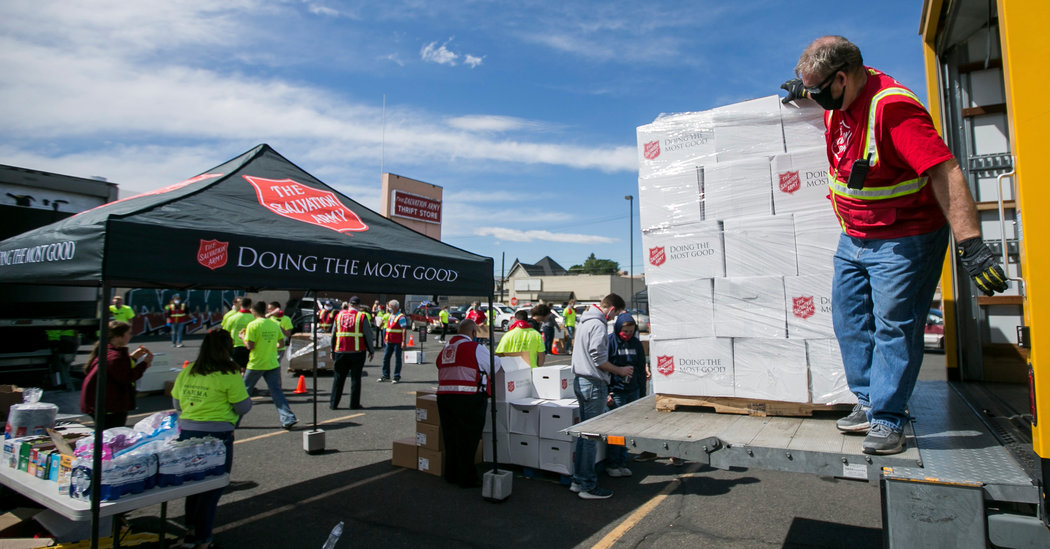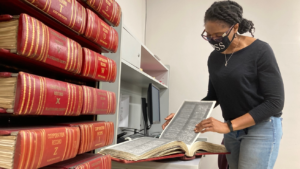WASHINGTON – For decades, the backbone of the nation’s disaster response system – and a hallmark of American generosity – has been its army of volunteers who run towards the threat to help victims of hurricanes, wildlife and other disasters, feed and counsel .
However, the Kovid-19 epidemic has highlighted a significant weakness in the system: Most volunteers are elderly people at high risk from the virus, so they cannot participate individually this year. More than 5 million volunteers typically work annually in disaster relief, said Greg Forrester, president of the association of nonprofit groups active in national volunteer organizations, but they expect a 50 percent drop in numbers this year.
Asked how disaster relief efforts could meet the general demand with half the people, Mr. Forrester said: “You didn’t.”
It is the latest in a wide range of problems that are already facing a catastrophic system that is expected to be one Unusually severe The hurricane season is combined with disasters such as this week’s dam breakdown and floods in Michigan, particularly flooding in the state by Kovid-19.
The Federal Emergency Management Agency is Running low Viruses as highly trained personnel reduce their workforce. Long process of sheltering victims in gymnasiums or other crowded places Suddenly dangerous Because they are prone to worsening epidemics. And traditional agreements between states to help each other if crises are now colliding because states are wary of exposing their own people to the virus.
It is one of the most severe tests in decades for a system designed to respond to local or regional storms or other disasters – not crises nationally. So far FEMA has been forced to take a primary role in Kovid-19, deploying more than 3,000 employees nationwide and effectively running its first 50-state disaster response.
“An epidemic has complicated every aspect of disaster planning and response in a way we’ve never experienced before,” said Chris Curry, who’s team at the non-government government accountability office that oversees emergency management Leads. “You are only good as the weakest link.”
FEMA says it has taken steps to prepare for the hurricane season, including expanding its coordination center in Washington, hiring staff and working with state and local officials to adapt to the epidemic, and non- For-profit organizations are involved. FEMA’s administrator, Peter Gaynor, said, “We have not lost sight of how to deal with other disasters occurring in the meantime.”READ Throwing stick signs at hunting techniques of ancient ancestors
On Wednesday, the agency said as much as possible to avoid this year, instead of sending relief workers to disaster areas this year, relying on “virtual” assistance such as talking to survivors on the phone, photos or Using other documentation of storm damage. Claiming and meeting online with state and local counterparts rather than in person.
Volunteers are critical to America’s disaster response, distributing supplies, clearing debris, and rebuilding homes. In interviews, officials of non-profit organizations that helped organize volunteer teams said that in normal years, they would train and equip thousands of people and help them fly to any part of the country, then help them Housing and feeding them is needed. In close quarters.
Suddenly, no one works.
According to Jeff Gellett, the group’s disaster coordinator for Southern Disaster, the Salvation Army volunteers 65 or more for most disasters. For those people, “We’re telling them, it’s probably not the best time for you to deploy,” he said, noting that older people are at particularly high risk from the Kovid-19.
There can be massive consequences: The Salvation Army has more than 2.7 million volunteers annually for everything from disaster response to school programs and business events. Disaster volunteers worked 3.5 million hours during the 2017 hurricane season.
The Salvation Army is considering using overpaid employees and placing them in hotels instead of dormitories. But it is expensive, Mr. Gellets said, and the epidemic has closed the Salvation Army’s thrift stores, bringing in about $ 600 million in sales annually.
Habitat for Humanity, which helped rebuild or repair about 700 homes damaged by disasters in the United States last year that many of its volunteers receive from older Americans, according to Chief Executive Officer Jonathan Wreckford. Considering the risks of air travel to the danger that volunteers inadvertently bring disease to the community they are trying to help, Mr. Wreckford said that Habitat for Humanity has deployed any volunteers, Had stopped till now.READ Coronavirus live update: infection numbers climb higher in South Korea
In total, the organization fielded 1.2 million volunteers last year for all its work. It does not break a number for disaster response.
This means that its group is not able to react to what this storm usually does to attack the United States this year. “This is our biggest fear right now,” Mr. Rakeford said.
If there was a massive disaster in the country that was under massive quarantine, “we really have to overcome something from our response in those areas,” with Mary Casey-Locker, a senior aide for the Disaster Health Program The American Red Cross said during a webinar for nonprofits last week. The Red Cross deployed 9,000 workers in major disasters last year; It expects that half of the volunteers will be deployed as usual this year.
Cathy Earl, director of disaster response for the United Methodist Committee on Relief, said & # 39; & # 39; I do not want to imagine a world where it is so bad that we can answer it. & # 39; & # 39; She said how many volunteers were difficult to deploy this year, but the 50 percent reduction was called “a reasonable estimate”.
The lack of volunteer threatens to exaggerate the nation’s disaster response system, other problems.
A spillover effect would be financial. Under federal law, state or local governments typically have to shell out $ 25 for every $ 75 that the federal government provides for disaster relief. But he was allowed to count the services of volunteers toward that amount, Mr. Forester said.
As a result, fewer volunteers mean cities, counties and states need to come up with their own funds to receive federal aid.
But local governments are already financially battling the virus. Counties alone have seen $ 144 billion According to the National Association of Counties, in lost income and increased expenditure, one-fifth of their total budget. “Our costs have skyrocketed and our revenues are declining,” association spokesman Paul Guequier said.READ How an eye surgeon found a picture of this rare pastel bird
At the same time, the federal government is asking local authorities to take up new tasks.
One of the most difficult challenges will be to evacuate and shelter people Without spreading the virus. After the dam collapsed in Michigan this week, Gewerten Whitmer accepted It will be difficult to distinguish social in the shelters.
This week FEMA gave advice State and local governments find ways to find backup sources for supplies, distribute them without physical contact, figure out how to prevent disaster survivors from gathering in groups, and ask volunteers to “lower Support “.
Under his new guidance, FEMA also prepared a set of new challenges facing disaster shelters. Local authorities said, people with Kovid-19 should look for more space to shelter.
FEMA also urged local authorities to revise their plans to deal with the pets of disaster victims, as placing regulations in shelters meant there may not be room for them.
When states do not have enough people to respond to a disaster, they usually ask other states to send their emergency management team. But with Kovid-19, “they’re not sure what they might need in their states,” said Joyce Flynn, Iowa’s emergency management director and head of the committee of the National Emergency Management Association that oversees it Mutual aid system.
When those alternatives prove insufficient, cities and states have to turn to FEMA for support. However, the agency was already Spread thin Disasters are more frequent and acute due to climate change. Virus crisis has increased it Further.
Brock Long, who led FEMA during the devastating hurricanes and wildfires of 2017 and 2018, said there was only so much the agency could do. “They are getting off the bench in a basketball game like a sixth man, down from 20, and being asked to win the game,” Mr. Long said. “We win and lose together.”




